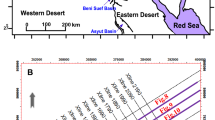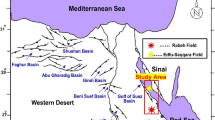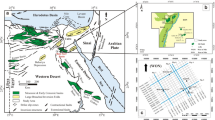Abstract
This study suggests a suitable stratigraphic trap in West Hurghada area at the southwest Gulf of Suez Basin based on the interpretation of seismic and well logging data. This stratigraphic trap formed by lateral and vertical facies change from porous limestone to massive marl within Rudeis Formation. The examination of the available mud logs revealed that Rabeh East-22 Well displays positive criteria opposite a thick limestone interval between depths 4550 and 4630 ft (zone 1) to be considered a potential oil-bearing zone. This thick limestone bed did not appear in the other examined wells (Nageh-1, Rabeh East-8, and Rabeh East-25) which are so close to Rabeh East-22 Well confirming the lateral facies change. The expected stratigraphic trap on seismic data extends for about 1.5 km in north-south direction and for 0.75 km in east-west direction throughout the study area. The quantitative petrophysical analysis for this thick limestone interval (zone 1) in Rabeh East-22 Well indicated that the interval between 4569 and 4595 ft (26-ft thick) represents the most promising interval within zone 1. This promising interval reflects good reservoir characteristics with average hydrocarbon saturation of 53%, average shale volume of 21%, average total porosity of 20%, average effective porosity of 15%, and average bulk volume of water of 0.07.







Similar content being viewed by others
References
Abd El Gawad E, Abd El Hafez N, Hammed MS, El Naggar HA (2016) Characterization of pre-rift reservoirs of western Hurghada district, Egypt. Int J Innov Sci Eng Technol 3(12):74–83
Abd Elhady MA, Ahmed ASS, Metwaly AM (2017) New hydrocarbon prospect determenation via subsurface and petrophysical evaluation of rudeis formation, Belayim Land Oil Field, Gulf of Suez, Egypt. International Journal of Scientific Engineering and Applied Science (IJSEAS) 3(6)
Abul Karamat S, Meshref W (2002) Reverse fault geometry in the Gulf of Suez Rift Basin, Egypt. In: International Petroleum Conference and Exhibition, pp 27–30
Afify WEA, Hassan AHI (2013) Characterization of reservoir rock types in the upper Rudeis reservoir rocks, Gulf of Suez, Egypt. Adv Appl Sci Res 4(4):232–241
Alsharhan AS, Salah MG (1994) Geology and hydrocarbon habitat in a rift setting: southern Gulf of Suez, Egypt. Bull Can Petrol Geol 42(3):312–331
Archie GE (1942) The electrical resistivity log as an aid in determining some reservoir characteristics. Petrol Technol 5:54–62
Atta MA, Shahin AN, Blanchard D, David H (2002) Petroleum potential of the Gemsa Basin, southern Gulf of Suez, Egypt. In: International Petroleum Conference and Exhibition, pp 27–30
Bosworth W, El-Hawat AS, Helgeson DE, Burke K (2008) Cyrenaican “shock absorber” and associated inversion strain shadow in the collision zone of northeast Africa. Geology 36(9):695–698
Buckles RS (1965) Correlating and averaging connate water saturation data. J Can Pet Technol 4(1):42–52
Chowdhary LR, Taha S (1987) Geology and habitat of oil in Ras Budran field, Gulf of Suez, Egypt. AAPG Bull 71(10):1274–1293
Dolson JC, Bahorich MS, Tobin RC, Beaumont EA, Terlikoski LJ, Hendricks ML (1999) Treatise of petroleum geology/handbook of petroleum geology: exploring for oil and gas traps. Chapter 21: exploring for stratigraphic traps
Dolson J, Marfurt K, He Z, Horn BW (2017) Advances and perspectives on stratigraphic trap exploration-making the subtle trap obvious. AAPG Middle East region geosciences technology workshop. Stratigraphic Traps of the Middle East, Muscat, Oman
Egyptian General Petroleum Corporation (EGPC). (1996) Gulf of Suez oil fields (a comprehensive overview). EGPC, Cairo, Egypt 387 pp
El Nady MM, Mohamed NS, Shahin AN (2016) Source-rock potential of Miocene-Paleozeoic sediments in GH-376 oilfield, South Gulf of Suez, Egypt. Energy Source Part A 38(1):100–109
El Sharawy MS, Nabawy BS (2018) The role of gamma-ray logs in deciphering geochemical and geological aspects of the Rudeis Formation, Gulf of Suez, Egypt. Arab J Geosci 11(10):242
El Srogy SA, Helal IH, Amer EI, Mohamed HA (2002) Hydrocarbon generation, expulsion and migration in the Geisum and Tawila oil fields-southern Gulf of Suez. Inter Petrol Confer and Exhibit 1(5)
Evans AL (1988) Neogene tectonic and stratigraphic events in the Gulf of Suez rift area, Egypt. Tectonophysics 153(1–4):235–247
Metwalli MH, Phllip G, Youssef ESA (1978) El-Morgan oil field as a major fault-blocks reservoir masked by the thick Miocene salt; a clue for deeper reserves of hydrocarbons in Gulf of Suez Petroleum Province, Egypt. Acta Geol Pol 28(3):389–314
Nabawy BS, Rashed MA, Mansour AS, Afify WSM (2018) Petrophysical and microfacies analysis as a tool for reservoir rock typing and modeling: Rudeis Formation, off-shore October oil field, Sinai. Mar Pet Geol 97:260–276
Nabawy BS, Mansour AS, Rashed MA, Afify WSM (2019) Implementation of sedimentary facies and diagenesis on the reservoir quality of the Aquitanian-Burdigalian Rudeis Formation in the Gulf of Suez, Egypt: A comparative surface and subsurface study. Geol J. https://doi.org/10.1002/gj.3683
Pickett GR (1972) Practical formation evaluation. G.R. Pickett, Inc., Golden, Colorado
Poupon A, Leveaux J (1971) Evaluation of water saturation in shaly formations. In: SPWLA 12th annual logging symposium. Society of Petrophysicists and Well-Log Analysts
Sarhan MA (2017) The efficiency of seismic attributes to differentiate between massive and non-massive carbonate successions for hydrocarbon exploration activity. NRIAG J Astron Geophys 6(2):311–325
Sarhan MA, Basal AMK (2019) Evaluation of Nubia sandstone reservoir as inferred from well logging data interpretation for Rabeh East-25 well, southwest Gulf Of Suez, Egypt. J Afr Earth Sci 155:124–136
Sarhan MA, Basal AMK, Ibrahim IM (2017) Integration of seismic interpretation and well logging analysis of Abu Roash D Member, Gindi Basin, Egypt: implication for detecting and evaluating fractured carbonate reservoirs. J Afr Earth Sci 135:1–13
Schlumberger (1972) Log interpretation/charts. Schlumberger Well Services, Inc., Houston
Shahin AN, Shehab MM (1984) Petroleum generation, migration and occurrence in the Gulf of Suez offshore, south Sinai: 7th Egyptian General Petroleum Corporation. In: Petroleum Exploration and Production Conference Vol. 1, pp 126–152
Steckler MS, Berthelot F, Lyberis N, Le Pichon X (1988) Subsidence in the Gulf of Suez: implications for rifting and plate kinematics. Tectonophysics 153(1–4):249–270
Sultan N (2002) Gulf of Suez/Red Sea structural evaluation and hydrocarbon potentiality. In: International Petroleum Conference and Exhibit, p 82
Takasu Y, Ganoub AF, Hirano M (1982). Exploration history and geology of west Bakr fields, Eastern Desert, Egypt. GPC, Sixth Exploration Seminar, March 7-10, Egypt, p 14
Zaid SM (2012) Provenance, diagenesis, tectonic setting and geochemistry of Rudies sandstone (lower Miocene), Warda Field, Gulf of Suez, Egypt. J Afr Earth Sci 66:56–71
Acknowledgments
I would like to express my special gratitude to Ganoub El-Wadi Petroleum Holding Company and the Egyptian General Petroleum Corporation (EGPC) for providing the data required for this work.
Author information
Authors and Affiliations
Corresponding author
Additional information
This article is part of the Topical Collection on Current Advances in Geological Research of Egypt
Rights and permissions
About this article
Cite this article
Sarhan, M.A. Geophysical appraisal and oil potential for Rudeis Formation at West Hurghada area, southern Gulf of Suez: detection of stratigraphic trap. Arab J Geosci 13, 263 (2020). https://doi.org/10.1007/s12517-020-5277-0
Received:
Accepted:
Published:
DOI: https://doi.org/10.1007/s12517-020-5277-0




